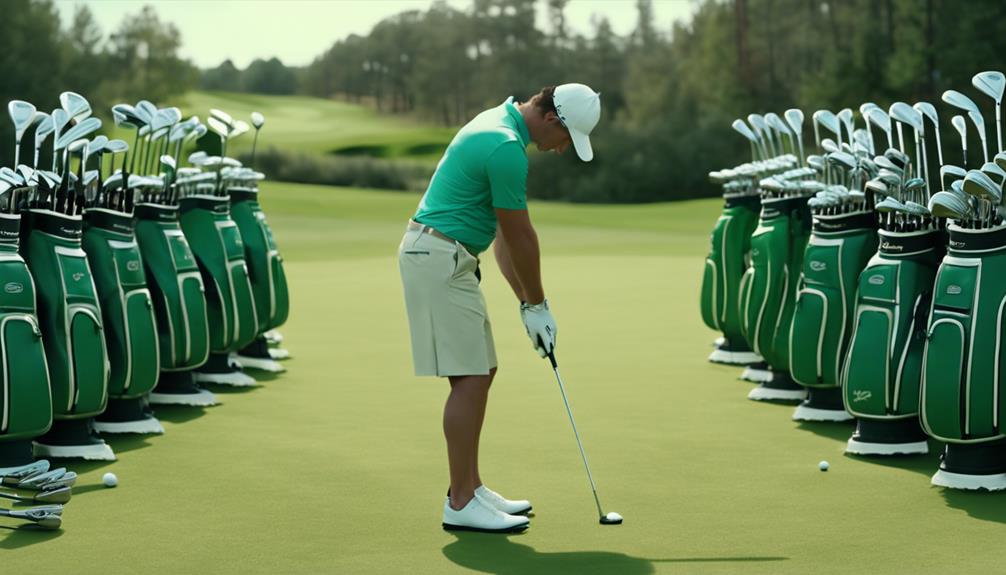- 7 Top Flite Golf Clubs XL for Improved Performance - September 28, 2024
- Top Flite Golf Clubs: Top 5 Reasons to Choose Them - September 28, 2024
- Top 3 Golf Club Fitters for a Perfect Swing - September 28, 2024
When you hold a chipper golf club, you're gripping a hybrid of a putter and wedge, designed specifically for short-range shots, with a loft that typically ranges from 30 to 45 degrees and a wider sole that enhances turf interaction, allowing for smooth, consistent swings. This club combines the forgiveness of a putter with the versatility of a wedge, making it ideal for beginners, mid-handicappers, and senior golfers. With a shorter shaft and compact size, you'll experience improved feel and control, and its design simplicity makes it easy to master. As you dig deeper, you'll discover how to access its full potential.
Key Takeaways
- A chipper golf club combines features of a putter and wedge, with a loft between 30-45 degrees, to simplify short-range shots.
- The wider sole design enhances turf interaction, allowing for smooth and consistent swings, while the shorter shaft improves feel and control.
- The chipper's compact size and balanced weight enable easy maneuverability, making it suitable for beginners, mid-handicappers, and senior golfers.
- To use a chipper effectively, adopt a narrow stance, pendulum-like swing, and strike the ball at the bottom of the swing arc for consistent results.
Understanding the Chipper Club
As you explore the world of golf, understanding the chipper club's unique characteristics is vital to harnessing its full potential.
The chipper golf club combines features of a putter and a wedge, designed specifically for short-range shots around the green. You'll notice the loft is typically between 30 to 45 degrees, making it perfect for those tricky shots.
The design of a chipper includes a wider sole for better turf interaction, a shorter shaft for improved feel, and alignment aids for easier targeting. These features allow you to focus on your swing, rather than worrying about the club's performance.
When you hold a chipper, you'll notice its compact size and balanced weight, making it easy to maneuver.
To get the most out of your chipper, it's essential to understand its design and how it's meant to be used. By grasping these fundamentals, you'll be well on your way to mastering the chipper and taking your game to the next level.
Benefits and Target Audience
Mastering the chipper club yields numerous benefits, particularly for golfers who struggle with making clean contact on chip shots. Its versatility makes it an attractive option for a wide range of players. As you explore the world of chipper golf clubs, you'll discover that they offer a unique set of advantages that can elevate your short game.
Here are three key benefits you can expect from using a chipper club:
- Improved forgiveness: Chippers provide more room for error, reducing the likelihood of chunking or skulking the ball.
- Enhanced versatility: With a chipper, you can execute low-flying shots while still having the option to use traditional wedges for higher, softer shots when needed.
Whether you're a beginner, mid-handicapper, or senior golfer, the chipper club is an excellent addition to your arsenal of golf clubs. By incorporating a chipper into your game, you'll find that it's easier to control distance and accuracy on delicate shots, leading to improved overall performance.
Ideal Usage Situations and Techniques

When faced with short shots within 30 yards of the green, you'll find that a chipper club excels in tight lies and tricky situations where traditional wedges often struggle to deliver.
Ideal usage situations for a chipper include shots from the fringe, light rough just off the green, and low, running chip shots over short patches of grass.
To get the most out of your chipper, maintain a narrow stance and adopt a pendulum-like swing, keeping your grip firm to stabilize your wrists without wrist hinging.
This technique allows you to produce a slightly higher ball flight, making it easier to navigate obstacles near the green.
You'll particularly benefit from using a chipper when faced with minimal obstacles in front of the hole, as this allows for better accuracy and distance control.
Design Features and Legal Compliance
You'll find that the design features of a chipper golf club are specifically tailored to optimize its performance, with key characteristics including a loft between 30-45 degrees, a wider sole for improved turf interaction, and a shorter shaft for enhanced feel and control.
Here are three essential design features to note:
- Loft and Sole Design: The wider sole and higher loft angle work together to prevent the club from digging into the turf, allowing for a smooth, consistent swing.
- Shaft Length and Feel: The shorter shaft provides a more controlled feel, making it easier to precision-approach the green.
As you explore the world of golf chippers, remember that they must comply with USGA and R&A standards to be legal for competitive play. This means they must have a single striking face and a loft exceeding 10 degrees.
Effective Techniques and Misconceptions

Now that you've got a grip on the design features and legal compliance of chipper golf clubs, it's time to focus on making the most of this versatile club.
To execute chip shots like a pro, you'll need to master the techniques that set chippers apart from traditional wedges.
Chip Shot Execution
By maintaining a narrow stance and positioning your hands slightly ahead of the clubhead, you can execute a chip shot with a chipper that yields consistent results. This setup allows for a smooth, pendulum-like swing without wrist hinging, ensuring a clean strike.
Here are the key elements to focus on for an effective chip shot:
- Stance and setup: Maintain a narrow stance with your hands slightly ahead of the clubhead, promoting a smooth swing.
- Swing arc: Strike the ball at the bottom of the swing arc, ensuring a consistent and controlled strike.
Common Misconceptions Debunked
Despite their growing popularity, chippers are often misunderstood, and several misconceptions surrounding their use and effectiveness persist among golfers of all skill levels.
You might think that chippers are only for beginners, but you're wrong. They can be a valuable tool for players of all levels, including mid-handicappers and seniors seeking control around the green.
Another myth is that chippers are illegal in competitive play, but they're permitted as long as they adhere to USGA regulations regarding design and loft.
Don't believe that chippers limit shot versatility; they excel in certain situations, such as tight lies and short distance shots, where traditional wedges might struggle.
And, no, chippers don't replace traditional wedges entirely; they serve as a supplementary option, especially for bump-and-run style shots.
It's also essential to understand that chippers require proper technique, including a pendulum-like swing and a firm grip to maintain control and consistency.
Mastering the Chipper Swing
To develop a consistent chipper swing, you'll want to start by adopting a narrow stance with your feet closer together, positioning your weight slightly on your front foot to achieve better balance and control throughout the swing. This stance will help you maintain a steady base, allowing you to focus on the finer details of the chipper swing.
Here are three key elements to master for the best golf:
- Grip and stance: Hold the chipper firmly to stabilize your wrists, and address the ball as you'd with a putt, ensuring your hands are ahead of the clubhead at impact.
- Swing tempo: Use a softer force than a typical putt, adjusting your swing speed to account for reduced air resistance and the chipper's design.
Choosing the Right Chipper Loft

When selecting a chipper, you'll need to contemplate the right loft for your game, as it can greatly impact your short game performance.
You'll want to think about the types of courses you typically play, as well as your own skill level and comfort with different lofts.
Chipper Loft Options
Your chipper's loft angle plays a critical role in determining the trajectory and overall success of your shots, especially around the green. When it comes to chipper loft options, you have a range to choose from, typically between 30 and 45 degrees.
Here are three key considerations to keep in mind:
- Links courses: Opt for a lower loft (32-34 degrees) to produce a lower, running shot that can navigate tight lies and firm turf.
- Mountain courses: A higher loft (36-37 degrees) can help you clear obstacles and navigate thicker rough.
Course-Specific Loft Selection
By understanding the unique demands of different course types, you can select a chipper loft that's tailored to the specific challenges you'll face, ensuring more consistent and effective play. This course-specific loft selection is essential to optimize your chip shots and adapt to varying terrain.
| Course Type | Recommended Loft | Characteristics |
|---|---|---|
| Links | 32-34° | Low, running shots on firm terrain |
| Parkland | 34-35° | Versatility for various lies and distances |
| Desert | 34-35° | Control on hard, firm ground |
| Mountain | 36-37° | Higher trajectory for elevation changes |
Ideal Loft for Beginners
Selecting the ideal chipper loft is crucial for beginners, as it directly impacts the consistency and effectiveness of short chip shots around the green. As a beginner, you'll want to focus on finding a loft that provides a balance between lift and roll.
Here are three key factors to bear in mind:
- Loft range: A chipper typically has a loft between 30 to 45 degrees, similar to a 7-iron. For beginners, a loft around 34-37 degrees is often ideal.
- Sole design: A wider sole design can help you improve turf interaction, allowing for smoother contact even on tight lies or in light rough.
When choosing the ideal loft for your chipper, remember that it's important to find a balance that suits your swing mechanics and comfort level.
You may need to try out different lofts within the recommended range to find the one that works best for you. By doing so, you'll be able to improve your short game performance and become a more confident golfer.
Chipper Vs Wedge: Key Differences
When it comes to making precise, low-flying shots, understanding the key differences between a chipper and a wedge is essential. As a golfer, you need to know when to reach for each club to optimize your short game.
Here's a breakdown of the key differences between chippers and wedges:
| Chipper | Wedge |
|---|---|
| Loft: 30-45° | Loft: Higher for softer landings |
| Face: Flat, wide sole | Face: Varied, narrower sole |
| Swing: Pendulum motion | Swing: Wrist hinge, varied angles |
With a chipper, you'll enjoy better turf interaction and cleaner contact from tight lies, making it perfect for short chips within 30 yards. The shorter shaft provides better control and feel, allowing you to focus on a smooth, putting-like swing. In contrast, wedges are more versatile but require a more complex swing and are better suited for pitches and flops. By understanding these key differences, you can choose the right club for the job and take your short game to the next level.
Common Misconceptions Debunked

As you explore the world of chipper golf clubs, you've likely encountered some misconceptions about their capabilities and limitations.
Now, it's time to separate fact from fiction and set the record straight on common myths surrounding these versatile clubs.
Let's examine the points where myth meets reality, and discover how chippers can actually enhance your short game performance.
Separating Fact From Fiction
Several myths surround the humble chipper golf club, but it's time to set the record straight and explore the facts that debunk these common misconceptions. As you consider using a chipper, it's crucial to separate fact from fiction.
Here are three key facts to keep in mind:
- Chippers are for all skill levels: Contrary to popular belief, chippers aren't just for beginners. They provide enhanced control and confidence around the greens, making them beneficial for golfers of all skill levels.
- Chippers are legal and versatile: Chippers are legal for competitive play as long as they comply with USGA regulations. They're designed for specific situations like low, running shots, making them effective alternatives to traditional wedges in certain scenarios.
Chippers Are Not Limited
By recognizing the facts that debunk common misconceptions, you can access the full potential of a chipper golf club, discovering that it's a versatile tool that's not limited to specific skill levels, lies, or conditions.
Contrary to popular belief, chippers aren't just for beginners; they're effective tools for golfers of all skill levels, including mid-handicappers and seniors seeking improved short game performance. In fact, many skilled players utilize chippers as a reliable alternative for specific shots, particularly low, running chips around the green.
The design features of chippers, including a shorter shaft and wider sole, enhance their usability, allowing you to execute precise chip shots with greater consistency. This means you can confidently use a chipper in various situations, from tight lies to thicker rough, without feeling limited.
Myths Surrounding Legality
Debunking common myths surrounding the legality of chippers is essential to understanding their full potential, and it starts with recognizing that chippers are, in fact, legal for use in official tournaments. You may have heard otherwise, but rest assured that chippers meet USGA and R&A regulations, including having only one striking face and a loft greater than 10 degrees.
Here are three common misconceptions about chippers:
- Chippers are only for beginners: Not true! Skilled players also use chippers to enhance their short game.
- Chippers are illegal: False! They're permitted in competitive play, so you can use them in tournaments without worrying about disqualification.
Simplifying the Short Game
Around the green, a chipper golf club proves to be a game-changer, allowing you to simplify the short game by taking a more putting-style approach to chip shots. With its unique design, you can eliminate the need for high-arc shots and instead focus on making consistent, low-running chips that get you closer to the hole.
| Benefit | Description |
|---|---|
| Improved Forgiveness | Wider sole and shorter shaft provide more room for error |
| Increased Accuracy | Putting-style stroke helps you make more consistent contact |
| Enhanced Turf Interaction | Design reduces likelihood of club getting stuck in grass |
Frequently Asked Questions
When Should You Use a Chipper in Golf?
You should use a chipper when faced with tight lies and minimal obstacles within 30 yards of the green, employing chipper techniques like fringe shots and bump-and-run approaches to achieve a controlled, lower ball flight.
Why Don't More People Use Chippers?
You're likely surprised that only 12% of golfers use chippers, despite their effectiveness. Player preferences for traditional wedges, fueled by misconceptions and stigma, lead to a hesitation to adopt chippers, limiting their use and potential to improve short game performance.
How Far off the Green Can You Use a Chipper?
You can use a chipper up to 30 yards off the green, employing chipper techniques like adjusting stance, alignment, and swing tempo to control distance and trajectory, ensuring a precise shot.
Are Chippers Legal on the PGA Tour?
You're wondering if chippers are legal on the PGA Tour? Yes, they are, as long as they meet Chipper Regulations, such as having a single striking face and a loft exceeding 10 degrees, like the Ping ChipR.
Conclusion
As you master the chipper golf club, your short game transforms into a symphony of precision and control, like a conductor expertly guiding his orchestra.
With its unique design and benefits, the chipper is an invaluable addition to your golf bag, helping you navigate tricky lies and tight pin positions with ease.
By understanding its features and techniques, you'll be chipping like a pro in no time, shaving strokes off your score and elevating your overall game.




